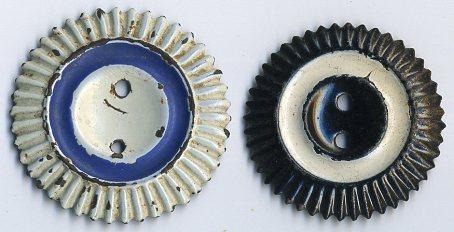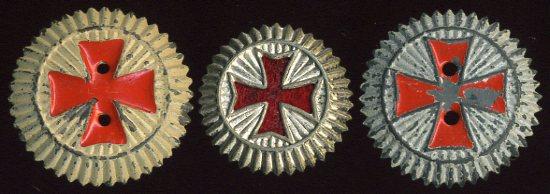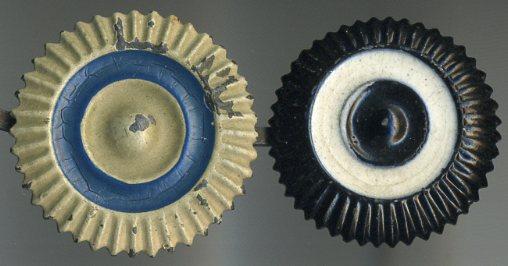-
Posts
2,962 -
Joined
-
Last visited
Content Type
Profiles
Forums
Blogs
Gallery
Events
Store
Posts posted by Chip
-
-
Andy,
According to the unit history, the Russian guns were replaced in the summer of 1917 by the new Infanterie Geschütz L20/17.
Chip
0 -
But! Could you post them in ascending order! (lol!!)
We plan to do that as soon as we have a photo from every unit.

 0
0 -
Hi Andy,
Yes, worked in tandem with, not part of. My history of the Sturm=Batl.Nr.1 also includes Infanterie Geschütze Batterie Nr.2's history, since they worked together most of the time.
0 -
I thought most Sturm Bataillone had an Infanterie Geschütz Batterie that it worked in tandem with.
0 -
Pretty cool. Any photos showing their straps or perhaps a closer view of the gun?
0 -
Chris,
Look at "Jockers" before it. It's a "k". Kork.
0 -
Since he is an artillerist, the grenade is used in the place of an acorn.
0 -
The Probe piece in the Bavarian Army Museum indicates that Flieger sleeve patches with Roman numerals only are to be worn by officers and enlisted men of Kampfgeschwader.
Chip
0 -
Eric,
The Bavarian's were pretty slap-dash with their manufacturing of straps. Their numbers were usually without serifs, the edges (as is the case here) were often mis-sewn so that they often opened easily. There must not have been any inspection, as they occasionally are seen with the edge sewing so far off that there is an open space between the two layers.
0 -
Ah, sometimes German humor flies right by me!
0 -
Master of handstands? Is that good or bad? It must be a German saying, but it does convey the intended meaning. I assume it means being good at something that no one cares about?
0 -
Jenette,
The medal appears to be the 1934 issued, Ehrenkreuz des Weltkriegs 1914/1918 (Honor Cross of the World War 1914/1918). This one is without swords and with the to next of kin ribbon. These Ehrenkreuz für Eltern (Honour Cross for Parents) were normally given to parents and widows of the fallen.
Chip
0 -
Trajan,
The Bavarian issue cockades are a bit larger and the white outer ring stands out making them look even larger in photos, where most other contingents that have darker rings. Here are two of the issue sew-on types for comparison. Interestingly, Saxon issue sew-on cockades are smaller than Prussian and all other state's versions.
Chip
0 -
Andy,
Two things. First, if that is not a "4", then what is it? Only Garde units had no unit numbers and this fellow is not from a Garde unit. Also, the number on the shoulder strap is "6.". Look where the "punkt" is.
Chip
0 -
Or it could be a Roman numeral "X". The serifs tend to make me think that is what it is.
Chip
0 -
I believe the two older men are wearing the uniform of the NS-RKB (Nationalsozialistische Reichs-Kriegerbund) or the Marinebund, who had the same insignia, but the navy subsection's insignia was gilt metal with an anchor, which is unclear here. They wore a dark blue suit. It was a veteran's organization. There were ranks within the Bund that were signified by the wearing of an armband on the lower left sleeve.
The young sailor in the middle has a cap band that reads "Marineartillerieabteilung" (Naval Artillery Detachment). There was normally a unit number before and after this name, but they cannot be seen in the photo. He is wearing the parade jacket (dress jacket).
"MaschOgfr" would have been his rank, Maschinen Obergefreiter (Mechanic NCO), two grades above a basic seaman (Matrose).
Chip
0 -
According to that site, if yours is Bayerische no. 4, then it was a Schwere Minenwerfer-Abteilungen.
During the period that this type of unofficial sleeve patch was worn, the shoulder strap number would reflect the pioneer unit that the MWA came from. So, this would not be the 4th Bavarian Schwere Minenwerfer-Abteilung. If there was an Abteilung number at all, it was normally shown on the sleeve patch. Later in 1915, when the new Minenwerfer shoulder strap was introduced, the unit number was displayed on them and the sleeve patches were dropped.
0 -
This last link to the monograms of German regiments, while interesting and shows that someone went to a lot of trouble, is unfortunately, incomplete and has errors. I can't say, however, that I have seen any better one on the Net to this point.
0 -
And, of course, he is not wearing a clergy armband.
0 -
-
That's nice and newer information than I have. I have an S.14, but am not a bayonet collector per se.
0 -
Well, I am not so sure it is a Prussian cockade... Some of those Bavarian cockades are rather deep blue and that, plus the angle the photograph was taken, might just account for it looking more black than blue...
That aside, I would think this is a late war period photograph on account of the absence of any Bavarian collar piping - but that is just conjecture on my part. I know that Bavarian units still had these in the early part of the GW, but don't recall when they stopped wearing them.
Hello,
Here is a comparison between a Bavarian and Prussian prong backed cap cockade. As anyone can see, they're not even close. Even in a black and white photo like this they are easily differentiated by the location of the white rings.
The Bavarian Rautenborte was introduced with their new uniform regulations in 1916 (if anyone needs the exact date, let me know). In the final months of 1917, it was ordered reduced to just a vertical strip on the front edges of the collar. This change was supposed to be in effect for the duration of the war, but in practice, many later war Bavarian tunics never had it applied. Of course, it was worn in the field, but period photos of this are few compared with photos of Bavarians without it.
0 -
At first I thought these men had Currasier cuffs so what is the difference in the uniform between Currasiers and Jaeger zu Pferde please?
It's a bit difficult to tell the difference in black and white photos. If you could see them in color, it would be another matter, as Jäger zu Pferde officers had green collars and cuffs, whereas the Kürassier had various regimental facing colors. The braids on those collars and cuffs were very similar and some even overlapped (meaning both a J.z.P. regiment and a Kürassier regiment wore the same braid). The shoulder boards would be another identifying attribute, but they are too far away in these photos to be of any help. Also, the base color of the tunics was different. Jäger zu Pferde wore graugrün and Kürassier wore feldgrau.
The second photo shows dark piping on the front edge and the cuffs, so he is from a different unit than the man in first photo.
Chip
0 -
Hello,
Here is the quote from Kraus, "Ein weiterer Entscheid von 14.9.1917 wies darauf hin, daß Wickelgamaschen nur für Fliegerformationen, planmäßige Sturm-Bataillone und Truppen mit Gebirgsausrüstung zugelassen seien." So, it was actually 1917 that this decision was made. He goes on to say that in practice, this directive was largely ignored.
Chip
0








Post your Imperial German Dog Tags
in Germany: Imperial Uniforms, Headwear, Insignia & Personal Equipment
Posted
Minen,
A nice new assortment. Especially interesting is the rectangular "M.G.Z." example. The variety of these tags is continually surprising to me.
Chip